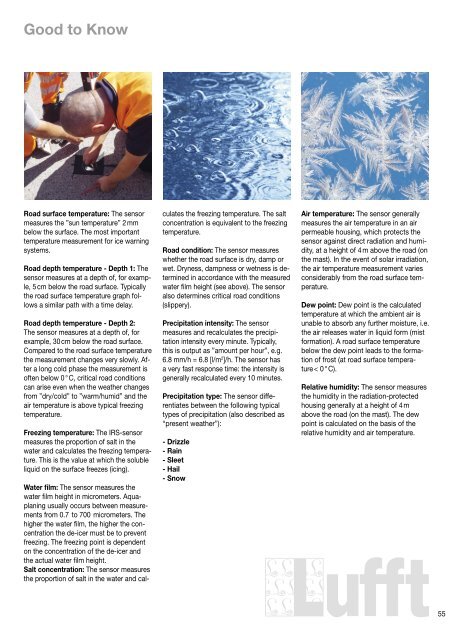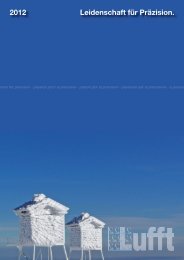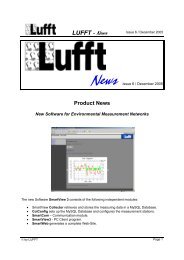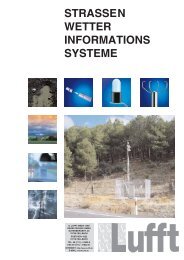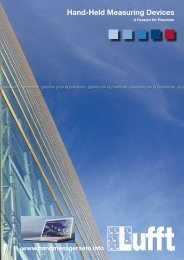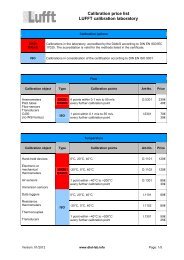UMB-Technology - Lufft GmbH
UMB-Technology - Lufft GmbH
UMB-Technology - Lufft GmbH
You also want an ePaper? Increase the reach of your titles
YUMPU automatically turns print PDFs into web optimized ePapers that Google loves.
Good to Know<br />
Road surface temperature: The sensor<br />
measures the ”sun temperature” 2 mm<br />
below the surface. The most important<br />
temperature measurement for ice warning<br />
systems.<br />
Road depth temperature - Depth 1: The<br />
sensor measures at a depth of, for example,<br />
5 cm below the road surface. Typically<br />
the road surface temperature graph follows<br />
a similar path with a time delay.<br />
Road depth temperature - Depth 2:<br />
The sensor measures at a depth of, for<br />
example, 30 cm below the road surface.<br />
Compared to the road surface temperature<br />
the measurement changes very slowly. After<br />
a long cold phase the measurement is<br />
often below 0 ° C, critical road conditions<br />
can arise even when the weather changes<br />
from ”dry/cold” to ”warm/humid” and the<br />
air temperature is above typical freezing<br />
temperature.<br />
Freezing temperature: The IRS-sensor<br />
measures the proportion of salt in the<br />
water and calculates the freezing temperature.<br />
This is the value at which the soluble<br />
liquid on the surface freezes (icing).<br />
Water film: The sensor measures the<br />
water film height in micrometers. Aquaplaning<br />
usually occurs between measurements<br />
from 0.7 to 700 micrometers. The<br />
higher the water film, the higher the concentration<br />
the de-icer must be to prevent<br />
freezing. The freezing point is dependent<br />
on the concentration of the de-icer and<br />
the actual water film height.<br />
Salt concentration: The sensor measures<br />
the proportion of salt in the water and calculates<br />
the freezing temperature. The salt<br />
concentration is equivalent to the freezing<br />
temperature.<br />
Road condition: The sensor measures<br />
whether the road surface is dry, damp or<br />
wet. Dryness, dampness or wetness is determined<br />
in accordance with the measured<br />
water film height (see above). The sensor<br />
also determines critical road conditions<br />
(slippery).<br />
Precipitation intensity: The sensor<br />
measures and recalculates the precipitation<br />
intensity every minute. Typically,<br />
this is output as ”amount per hour”, e.g.<br />
6.8 mm/h = 6.8 [l/m 2 ]/h. The sensor has<br />
a very fast response time: the intensity is<br />
generally recalculated every 10 minutes.<br />
Precipitation type: The sensor differentiates<br />
between the following typical<br />
types of precipitation (also described as<br />
“present weather”):<br />
- Drizzle<br />
- Rain<br />
- Sleet<br />
- Hail<br />
- Snow<br />
Air temperature: The sensor generally<br />
measures the air temperature in an air<br />
permeable housing, which protects the<br />
sensor against direct radiation and humidity,<br />
at a height of 4 m above the road (on<br />
the mast). In the event of solar irradiation,<br />
the air temperature measurement varies<br />
considerably from the road surface temperature.<br />
Dew point: Dew point is the calculated<br />
temperature at which the ambient air is<br />
unable to absorb any further moisture, i.e.<br />
the air releases water in liquid form (mist<br />
formation). A road surface temperature<br />
below the dew point leads to the formation<br />
of frost (at road surface temperature<br />
< 0 ° C).<br />
Relative humidity: The sensor measures<br />
the humidity in the radiation-protected<br />
housing generally at a height of 4 m<br />
above the road (on the mast). The dew<br />
point is calculated on the basis of the<br />
relative humidity and air temperature.<br />
55


